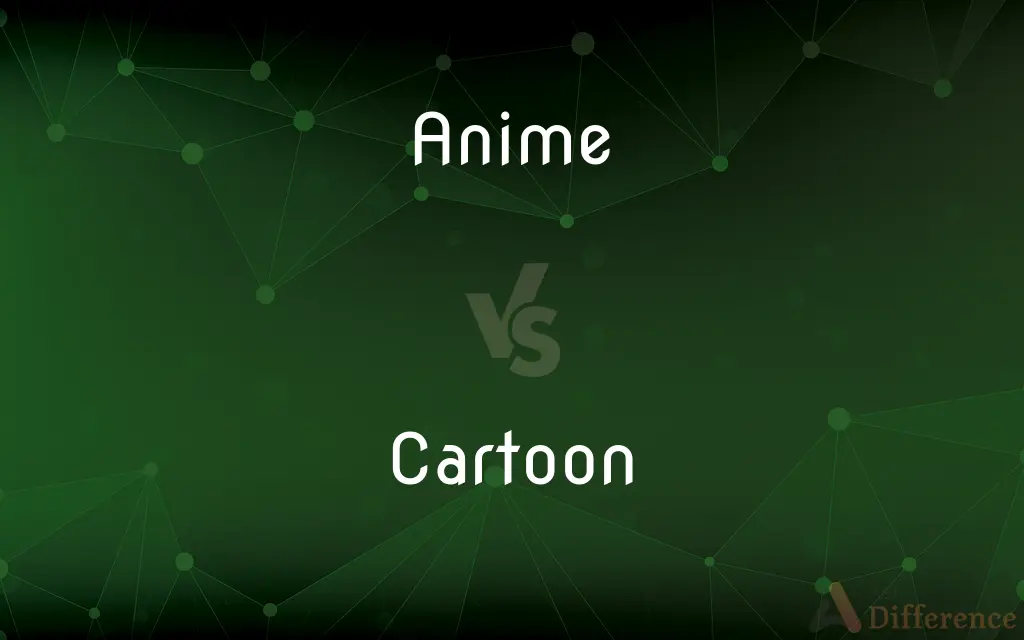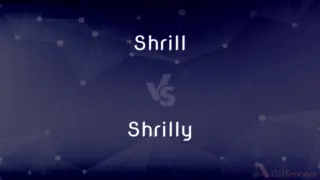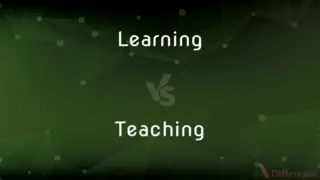Anime vs. Cartoon — What's the Difference?
By Maham Liaqat & Fiza Rafique — Updated on March 19, 2024
Anime, originating from Japan, features diverse art styles and thematic complexity, whereas cartoons, typically Western, often emphasize humor and simplified visuals.

Difference Between Anime and Cartoon
Table of Contents
ADVERTISEMENT
Key Differences
Anime, a term derived from Japan, encompasses a wide range of animated works with various art styles, often characterized by vibrant graphics, fantastical themes, and vibrant characters. While anime can cater to all age groups, it is known for its ability to explore complex narratives and emotional depth. On the other hand, cartoons are usually associated with Western animation and are often characterized by exaggerated features, humor, and a clear distinction between good and evil. Cartoons are primarily aimed at children, though some are created with a broader audience in mind.
The art style in anime is diverse, with characters frequently having detailed and realistically proportioned features, although stylized elements like large eyes are common. This contrasts with cartoons, where characters often have more exaggerated and less consistent designs, focusing on simplicity and expressiveness. Anime's visual richness extends to its backgrounds and settings, which are often meticulously detailed, whereas cartoons typically use more straightforward and less detailed backgrounds.
Anime storytelling is known for its depth and breadth, covering a wide range of genres and themes, from romance and horror to science fiction and fantasy. The narratives can be complex, with intricate plots and character development. Conversely, cartoons often revolve around simple, episodic stories, focusing on humor and adventure, with straightforward plots that are resolved within a single episode or a short series of episodes.
Culturally, anime reflects Japanese traditions, societal norms, and philosophical concepts, making it a medium for cultural expression and exploration. It often incorporates elements of Japanese history, folklore, and pop culture. Cartoons, however, tend to reflect Western values and humor, often using satire and parody to comment on societal issues or just for entertainment.
The audience for anime is diverse, ranging from children to young, with certain genres and series specifically targeting mature audiences. This is in contrast to cartoons, which, despite having some elder fans, are primarily produced for and consumed by children. The broader thematic exploration in anime allows it to resonate with a wider and more varied audience.
ADVERTISEMENT
Comparison Chart
Origin
Japan
Primarily Western
Art Style
Diverse, often detailed and realistic
Simplified, exaggerated features
Themes
Wide range, including complex and mature themes
Often humorous, simpler themes aimed at children
Storytelling
Can be complex with deep narratives
Generally simpler, episodic
Audience
All ages, with specific genres for elders
Primarily children, though some have wider appeal
Compare with Definitions
Anime
Japanese-style animation known for its diverse art and thematic complexity.
Attack on Titan explores themes of freedom and human resilience.
Cartoon
Western-style animation, often characterized by humor and exaggerated visuals.
Looney Tunes features slapstick comedy and iconic characters like Bugs Bunny.
Anime
Often features detailed characters and backgrounds.
Your Name showcases beautifully animated landscapes.
Cartoon
Can include satire and parody targeting a broader audience.
South Park uses mature humor and satire to comment on societal issues.
Anime
Can include a wide range of genres.
Death Note combines supernatural elements with psychological thriller aspects.
Cartoon
Simplified character designs for expressiveness.
The Simpsons uses distinctive, easily recognizable character styles.
Anime
Reflects aspects of Japanese culture and philosophy.
Spirited Away incorporates elements of Shinto beliefs and Japanese folklore.
Cartoon
Primarily aimed at children, with straightforward storytelling.
SpongeBob SquarePants focuses on comedic adventures in an episodic format.
Anime
Targets a broad audience, from children to elders.
Pokémon is popular among kids, while Psycho-Pass appeals to a more mature audience.
Cartoon
Often embodies Western cultural norms and values.
Tom and Jerry showcases a classic cat-and-mouse chase with universal themes of rivalry and humor.
Anime
Anime (Japanese: アニメ, IPA: [aɲime] (listen)) is hand-drawn and computer animation originating from Japan. In Japan and in Japanese, anime (a term derived from the English word animation) describes all animated works, regardless of style or origin.
Cartoon
A cartoon is a type of illustration that is typically drawn, sometimes animated, in an unrealistic or semi-realistic style. The specific meaning has evolved over time, but the modern usage usually refers to either: an image or series of images intended for satire, caricature, or humor; or a motion picture that relies on a sequence of illustrations for its animation.
Anime
(uncountable) An artistic style originating in, and associated with, Japanese animation, and that has also been adopted by a comparatively low number of animated works from other countries.
I can draw an anime version of you, if you want.
Cartoon
A drawing depicting a humorous situation, often accompanied by a caption.
Anime
(countable) An animated work that originated in Japan, regardless of the artistic style.
Cartoon
A drawing representing current public figures or issues symbolically and often satirically
A political cartoon.
Anime
An animated work, regardless of the country of origin.
Cartoon
A preliminary sketch similar in size to the work, such as a fresco, that is to be copied from it.
Anime
Alternative spelling of animé, the resin of the courbaril.
Cartoon
A usually short, animated movie or television program.
Anime
Of a different tincture from the animal itself; - said of the eyes of a rapacious animal.
Cartoon
An animated character in a movie or television program.
Anime
A resin exuding from a tropical American tree (Hymenæa courbaril), and much used by varnish makers.
Cartoon
A comic strip.
Anime
A hard copal derived from an African tree
Cartoon
A ridiculously oversimplified or stereotypical representation
Criticized the actor's portrayal of Jefferson as a historically inaccurate cartoon.
Anime
Any of various resins or oleoresins
Cartoon
To draw a humorous or satirical representation of; caricature.
Cartoon
To make humorous or satirical drawings.
Cartoon
(comics) A humorous drawing, often with a caption, or a strip of such drawings.
Cartoon
(comics) A drawing satirising current public figures.
Cartoon
(arts) An artist's preliminary sketch.
Cartoon
(arts) A full-sized drawing that serves as the template for a fresco, a tapestry, etc.
Cartoon
(animation) An animated piece of film which is often but not exclusively humorous.
Cartoon
A diagram in a scientific concept.
Cartoon
To draw a cartoon, a humorous drawing.
Cartoon
(arts) To make a preliminary sketch.
Cartoon
A design or study drawn of the full size, to serve as a model for transferring or copying; - used in the making of mosaics, tapestries, fresco pantings and the like; as, the cartoons of Raphael.
Cartoon
A large pictorial sketch, as in a journal or magazine; esp. a pictorial caricature; as, the cartoons of "Puck."
Cartoon
Same as comic strip.
Cartoon
A motion picture consisting of a series of frames, each being a photograph of a drawing rather than a frame produced by filming a scene of true action, and in which the objects are displaced slightly in succeeding frames so as to give the appearance of motion when projected as a motion picture on the screen. The types of characters portrayed in such films are often similar or identical to those in a comic strip.
Cartoon
A humorous or satirical drawing published in a newspaper or magazine
Cartoon
A film made by photographing a series of cartoon drawings to give the illusion of movement when projected in rapid sequence
Cartoon
Draw cartoons of
Common Curiosities
What defines anime as different from cartoons?
Anime is characterized by its diverse art styles, complex themes, and often deeper narratives, originating from Japan, whereas cartoons are typically Western, with more simplified visuals and humor-centric content.
Are anime and cartoons intended for the same audience?
While cartoons are primarily aimed at children, anime targets a wider range of age groups, including mature audiences.
Can cartoons have complex narratives like anime?
While less common, some cartoons do feature more complex stories and themes, though they generally maintain a focus on humor and simplicity.
Why do anime characters often have large eyes?
The large eyes in anime characters are a style choice that allows for greater expressiveness and emotional depth.
Is anime recognized as a form of art?
Yes, anime is widely recognized as a significant art form, both in Japan and internationally, appreciated for its storytelling, visuals, and cultural insights.
Is the animation quality different between anime and cartoons?
Anime often emphasizes detailed art and dynamic animation, while cartoons may opt for simpler, more stylized animation to complement their comedic and exaggerated nature.
How do cultural differences influence anime and cartoons?
Anime often incorporates Japanese cultural elements, while cartoons reflect Western values and humor, influencing their themes, storytelling, and character design.
How do the themes of anime and cartoons differ?
Anime's themes can range from light-hearted to profoundly philosophical, while cartoons typically focus on entertaining and straightforward themes.
How do advancements in technology affect anime and cartoons?
Technological advancements have enhanced the quality and accessibility of both anime and cartoons, leading to more sophisticated animation techniques and broader distribution.
Are all cartoons comedic and light-hearted?
While many cartoons are comedic, some can tackle serious themes, though they usually maintain a lighter tone compared to anime.
Can the term 'anime' refer to any animation outside of Japan?
While 'anime' is often used to describe Japanese animation, some use it more broadly to refer to a style of animation that resembles that of Japanese anime.
Are there cartoons with animation quality similar to anime?
Some Western animations adopt more detailed and sophisticated styles, blurring the lines between traditional cartoons and anime.
Why is anime popular worldwide?
Anime's diverse genres, deep storytelling, and unique art styles have garnered a global fanbase beyond its cultural origins.
Share Your Discovery

Previous Comparison
Shrill vs. Shrilly
Next Comparison
Learning vs. TeachingAuthor Spotlight
Written by
Maham LiaqatCo-written by
Fiza RafiqueFiza Rafique is a skilled content writer at AskDifference.com, where she meticulously refines and enhances written pieces. Drawing from her vast editorial expertise, Fiza ensures clarity, accuracy, and precision in every article. Passionate about language, she continually seeks to elevate the quality of content for readers worldwide.
















































